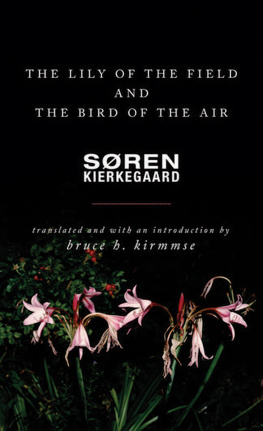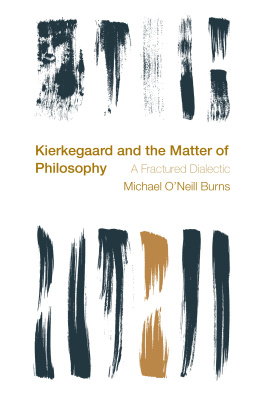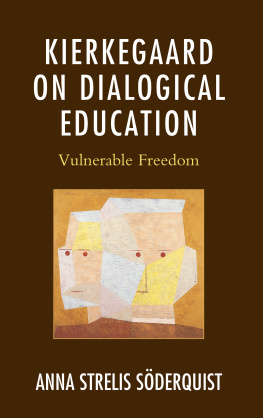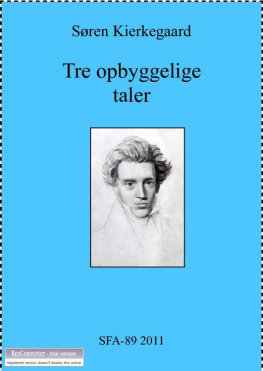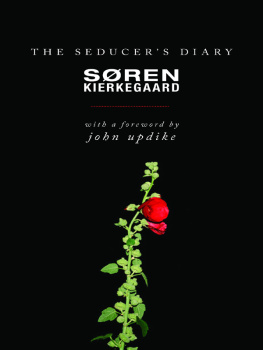Kierkegaard Søren - The lily of the field and the bird of the air: three godly discourses
Here you can read online Kierkegaard Søren - The lily of the field and the bird of the air: three godly discourses full text of the book (entire story) in english for free. Download pdf and epub, get meaning, cover and reviews about this ebook. City: Princeton;Oxford, year: 2018;2016, publisher: Princeton University Press, genre: Religion. Description of the work, (preface) as well as reviews are available. Best literature library LitArk.com created for fans of good reading and offers a wide selection of genres:
Romance novel
Science fiction
Adventure
Detective
Science
History
Home and family
Prose
Art
Politics
Computer
Non-fiction
Religion
Business
Children
Humor
Choose a favorite category and find really read worthwhile books. Enjoy immersion in the world of imagination, feel the emotions of the characters or learn something new for yourself, make an fascinating discovery.
- Book:The lily of the field and the bird of the air: three godly discourses
- Author:
- Publisher:Princeton University Press
- Genre:
- Year:2018;2016
- City:Princeton;Oxford
- Rating:3 / 5
- Favourites:Add to favourites
- Your mark:
- 60
- 1
- 2
- 3
- 4
- 5
The lily of the field and the bird of the air: three godly discourses: summary, description and annotation
We offer to read an annotation, description, summary or preface (depends on what the author of the book "The lily of the field and the bird of the air: three godly discourses" wrote himself). If you haven't found the necessary information about the book — write in the comments, we will try to find it.
Kierkegaard Søren: author's other books
Who wrote The lily of the field and the bird of the air: three godly discourses? Find out the surname, the name of the author of the book and a list of all author's works by series.
The lily of the field and the bird of the air: three godly discourses — read online for free the complete book (whole text) full work
Below is the text of the book, divided by pages. System saving the place of the last page read, allows you to conveniently read the book "The lily of the field and the bird of the air: three godly discourses" online for free, without having to search again every time where you left off. Put a bookmark, and you can go to the page where you finished reading at any time.
Font size:
Interval:
Bookmark:

the lily of the field
and
the bird of the air
THE LILY OF THE FIELD
AND
THE BIRD OF THE AIR
Three Godly Discourses
SREN KIERKEGAARD
Translated and with an introduction
by Bruce H. Kirmmse
PRINCETON UNIVERSITY PRESS
Princeton and Oxford
Copyright 2016 by Princeton University Press
Published by Princeton University Press,
41 William Street, Princeton, New Jersey 08540
In the United Kingdom: Princeton University Press,
6 Oxford Street, Woodstock, Oxfordshire OX20 1TW
press.princeton.edu
Jacket photograph: Pink Lilies (Liliaceae), Some in Bloom, Others Wilting. Courtesy of David Axelbank/ Gallery Stock
All Rights Reserved
Library of Congress Cataloging-in-Publication Data
Names: Kierkegaard, Sren, 18131855.
Title: The lily of the field and the bird of the air : three godly
discourses / Sren Kierkegaard; translated and with an
introduction by Bruce H. Kirmmse.
Other titles: Lilien paa marken og fuglen under himlen. English
Description: Princeton, NJ : Princeton University Press, 2016.
Identifiers: LCCN 2015035995 | ISBN 9780691170473
(hardback : alk. paper)
Subjects: LCSH: Christian lifeLutheran authors. |
Philosophy, Danish.
Classification: LCC BV4505 .K45513 2016 |
DDC 242dc23 LC record available at
http://lccn.loc.gov/2015035995
British Library Cataloging-in-Publication Data is available
This book has been composed in Adobe Caslon Pro
Printed on acid-free paper.
Printed in the United States of America
1 3 5 7 9 10 8 6 4 2
CONTENTS
BRUCE H. KIRMMSE vii

BY SREN KIERKEGAARD 1
INTRODUCTION
Letting Nature Point beyond Nature
BRUCE H. KIRMMSE
SREN KIERKEGAARD is perhaps most known for his pseudonymous works, including Either/Or, Fear and Trembling, and The Sickness unto Death, all of which have a clear (if not always immediately visible) religious undercurrent. But he also wrote a good many non-pseudonymous, overtly religious works, most of which consisted of what he called discourses (because he was not ordained, he felt it inappropriate to label them sermons). He made frequent use of Matthew 6:2434, a portion of the Sermon on the Mount, in which Jesus tells his followers to let go of earthly concerns by considering the lilies of the field and the birds of the air. This is a passage that can be interpreted in various ways and put to many different uses, and Kierkegaard had done so on numerous occasions prior to publishing the present For example, the second part of Upbuilding Discourses in Various Spirits, which Kierkegaard had published in March 1847, consisted of three discourses collectively titled What We Learn from the Lilies of the Field and the Birds of the Air, and the first part of Christian Discourses, published in April 1848, consisted of seven discourses that were also based on the lilies and the birds of Matthews gospel.
Kierkegaard delivered the manuscript of The Lily of the Field and the Bird of the Air to Bianco Lunos Printing House in Copenhagen on April 17, 1849, and by May 9, the fifty-one pages that constitute the first edition had been typeset; proofread three times by Kierkegaard and his secretary, Israel Levin; printed and bound in printed paper covers; and was ready to be sent to bookshops. On May 14, it was advertised in the newspaper Adresseavisen as available for purchase from the publisher, university bookseller C. A. Reitzel.
Just over a year earlier, on March 6, 1848, Kierkegaard had delivered the manuscript of Christian Presumably, the circumstance that Christian Discourses, which was to go on sale two days later, had made much use of the lily and the bird is what inspired Kierkegaard to think of producing a new set of discourses on the lilies and the birds, which in the event became the work in the present volume.
Kierkegaard also had a good deal of other work on his desk in 1848. He had begun writing The Sickness unto Death as early as February or In addition to all this, during the summer and autumn of 1848, Kierkegaard wrote The Point of View for My Work as an Author (posthumously published in 1859) as well as several shorter pieceshe called them notesalso concerning his work and his development as an author. A reworked portion of these pieces eventually coalesced into The Accounting, which formed the principal part of the little book On My Work as an Author, which Kierkegaard published in 1851.
Kierkegaard seems to have returned to the idea for new discourses on the lily and the bird in March 1849, and the writing then proceeded very quickly. Thus, the next month, April 1849, when The Lily of the Field and the Bird of the Air was already in the process of publication, Kierkegaard reflected on the difficulties he had experienced during the previous year in connection with the above-mentioned autobiographical notes concerning his life and work:
It was divine fortune that I didnt do it, didnt publish the notes, or that God didnt permit it to happen.
The degree to which it is God who directs the whole thing is clearest to me from the fact that the discourses on the lily and the bird were produced at that timeand that was just what I needed. God be praised! Without fighting with anybody and without speaking about myself, I said much of what needs to be said, but movingly, mildly, upliftingly.
After the publication of the present work in April 1849, Kierkegaard was by no means finished with considering the many ways in which the lily and the bird could be understood. Kierkegaard is a demanding writer and thinker. He never permits the reader to ease up on the oars and a reader might thus hope that difficulties will recede when the lily and bird in fact make an appearance. But Kierkegaard is never lax in this way. For Kierkegaard, Christianity is a moral and spiritual exercise that has the ultimate purpose of teaching human beings their imperfection, their weakness and selfishness, in the face of the perfection, majesty, and absolute otherness of God. To this end, in Kierkegaards theology the selfless suffering of Jesus Christ is meant to confront us human beings with our radical inadequacy and our selfishness, humbling us in our need for grace.
But, as Kierkegaard explains in another entry from the journal just cited, this is a not a very cheerful-sounding message, so human beings have So, is Kierkegaard abandoning the lily and the bird here? By no means. But this journal entry should serve to remind the reader that Kierkegaard was a tough-minded theologian who never gives his reader a free ride.
In 1850, about a year after he published this simple-seeming masterpiece, The Lily of the Field and the Bird of the Air, Kierkegaard jotted the But now, in the twenty-first century, it seems that the situation may have become sufficiently confused for us to make proper use of Kierkegaard. Nonetheless, there may be an air of something difficult or slightly forbidding in the reputation that surrounds the famous Danish thinker. So for a new reader of Sren Kierkegaard it might be useful to outline a few parallels toand significant differences fromone of his contemporaries, a figure perhaps more familiar to Americans, Henry David Thoreau.
The brief lives of these two loners, Kierkegaard (18131855, died at age forty-two) and Thoreau (18171862, died at age forty-four), coincided not only in
Next pageFont size:
Interval:
Bookmark:
Similar books «The lily of the field and the bird of the air: three godly discourses»
Look at similar books to The lily of the field and the bird of the air: three godly discourses. We have selected literature similar in name and meaning in the hope of providing readers with more options to find new, interesting, not yet read works.
Discussion, reviews of the book The lily of the field and the bird of the air: three godly discourses and just readers' own opinions. Leave your comments, write what you think about the work, its meaning or the main characters. Specify what exactly you liked and what you didn't like, and why you think so.

